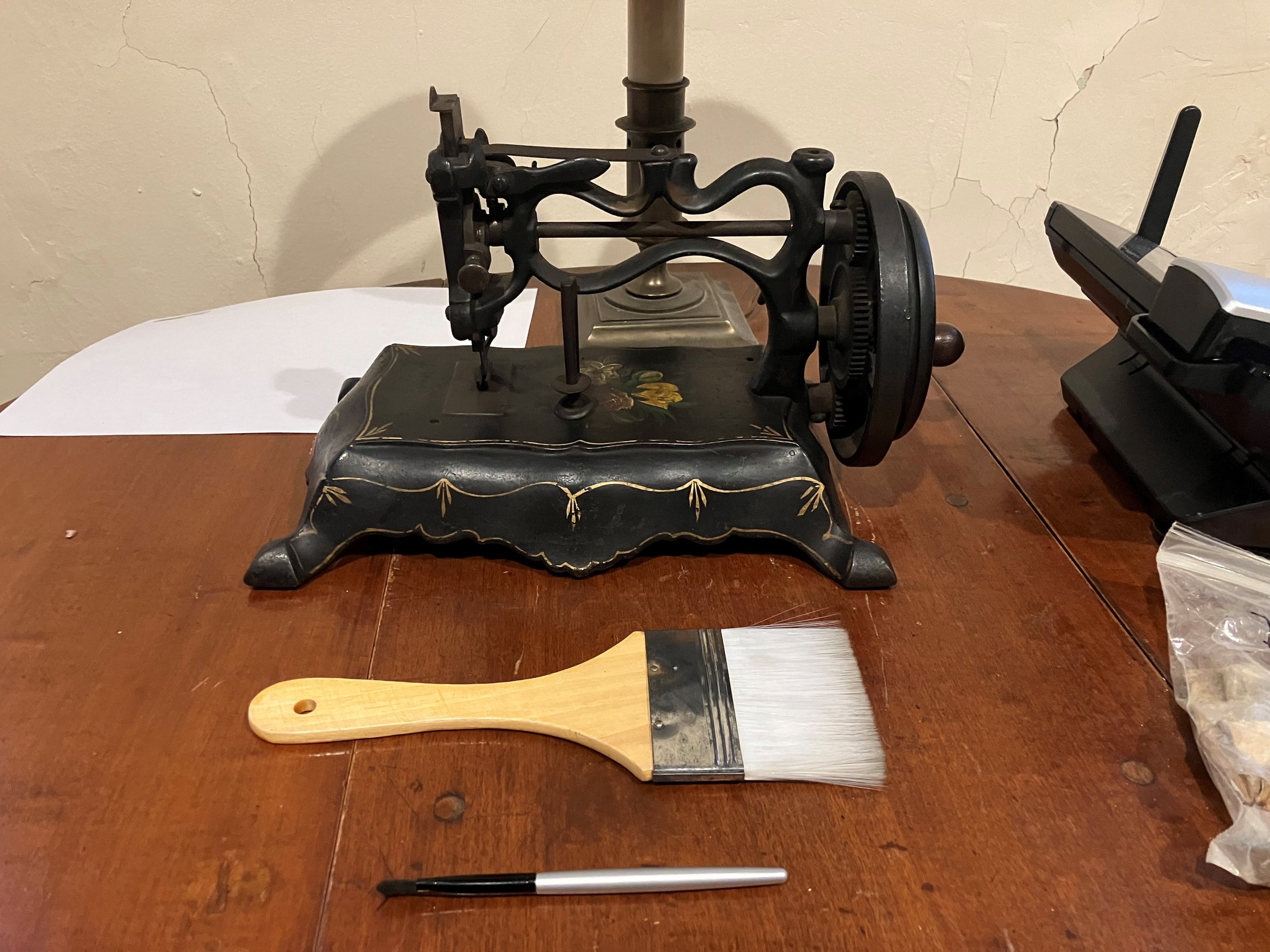A Stitch In Time
A Unique Sewing Machine on Display at Dunham Tavern
Duncan A. Virostko, Museum Assistant
Shaw & Clark Sewing Machine, ca. 1862, Undergoing conservation
When working on an exhibit, you sometimes discover objects in the museum's collection that are more than meets the eye. Such is the case with the subject of this article: a Shaw & Clark Sewing Machine, ca. 1862 . Although I’m something of a fan of hand-cranked sewing machines myself, even I must confess I had no real inkling of what I was looking at when I first discovered it. Rather, I was simply delighted to find we had an antique machine in our collection, as I was looking for something to give more context to the bottle of sperm whale oil used to lubricate such machines which was found archaeologically on the Dunham grounds for our revised archaeology exhibit, In Situ: 40 Years of Archaeology at Dunham Tavern.
Presentation of sewing machine to Museum, April 1974, Dunham Tavern Scrapbook.
The machine is so much more than an old sewing machine, however. It is a window into both the day to day work of people in the past, and a snapshot of technology at the time. The Shaw & Clark is of a style called the “spadefoot,” for the shape of the feet on its ornate cast iron base. Sewing machines had only been invented some twenty years prior and were considered to be a luxurious and modern item: hence they were ornately painted and designed to appeal to consumer tastes. Although less elaborate than other models, the “spadefoot” is nonetheless richly painted with roses and trimmed with gold lining. This kind of both austerely functional and yet ornate design is foreign to our 21st century eyes. The floral pattern of decoration would have delighted the intended users of the sewing machine: the long suffering women who would have previously sewn everything by hand, a process that is incredibly time consuming. It’s easy to imagine the elation the original owner of the machine, Miss. Cornelia Stillwell of Deposit, New York, must have felt when she first sat down to use it. It’s the same feeling many sewers today feel when they first start using a machine.
Bottom of Shaw & Clark Sewing Machine, showing complex echanisms
Yet the Shaw & Clark is not anything like your modern sewing machine. Modern machines are really a triumph of the Singer company. Singer entered early into the scene, in 1851, with the winning design of sewing machines: a lock-stitch machine, which uses a bobbin and thread. Competing machines, however, had a different system. They were chain stitch machines, the most famous and long-lived of which were by Wilcox & Gibbs. These created extremely fine chain stitches, differing from lock stitches by not requiring the machine to use a bobbin and being quite strong while also easily removed. (This type of stitch is still used today, primarily for closing feed sacks, where strength and ease of removal are assets.) Yet, it was the latter tendency of the chain stitch that worried the Shaw & Clark’s designers. Unless back stitched or finished by hand, chain stitches are easily pulled apart. The solution, as A.B. Shaw and numerous other inventors saw it, was simply taking a page from the lock-stitch machine's book and designing a sewing mechanism that used two spools of thread to create a stronger chain stitch.
If by this point your head is spinning from technical sewing jargon, and you are thinking “Isn’t all of this just a bit too complex?”, then congratulations. You have discerned what caused the Shaw & Clark, and machines like it, to fail. The machine is mechanically fascinating, but I will confess that even I am bamboozled by its arcane mechanisms. Unusually, as near as I can work out, our particular example had it’s two spools of thread mounted vertically, which is in slight variance to other machines made by Shaw & Clark, and indeed to the patent drawings that are referenced by the sole marking on the machine: “patented Dec 16 1862”, which had theirs mounted horizontally.
By far the most ingenious part of the machine, and that which I have been able to work out the operation of, is its feed & presser foot. This piece combines the function of a presser foot and feed mechanism that you’d find on a modern machine. The foot has a serrated bottom edge, and as you turn the hand wheel to move the needle up and down, the foot also moves up and down, slowly dragging the fabric through the machine one footstep at a time. There’s a small screw with a spring around it that allows you to adjust the amount of pressure the foot puts on fabric, presumably to allow you to adjust it for different thickness of cloth. It’s important to get that setting right, too! If over-tightened, then the machine jams up, and if you completely remove the bolt, then the camming operation of the foot ceases. It is truly a unique machine, with some unique quirks that are probably the reason the design did not stand the test of time.
“Patented Dec 18-1862”
But what about the people who made the machine? Well, Shaw & Clark were something of a shady concern. Based in Worcester, Massachusetts, the company spent its early years producing machines that were technically illegal copies of competitor machines. This is why our example has only a patent mark on it, and no other markings: it’s hard to sue a company that doesn’t put its name on its machines! There was a somewhat reasonable explanation for this behavior: at the time the “Sewing Machine Combine,” an early monopoly formed by legal agreement of major New England sewing machine manufacturers, was trying to force the competition to pay it licensing fees for the use of technology necessary to make a working machine. This would probably be illegal nowadays thanks to antitrust laws, which were inspired by public outcry against such arrangements in the 19th and 20th centuries. Nonetheless, the law caught up with Shaw & Clark, and in 1867 they lost a court case to the Combine, having to pay them fees and essentially partner with them in order to continue doing business. Ironically, Shaw & Clark’s brand became that of infringement crusader, often pointing out their competitors' machines were unlicensed copies unlike their own! This was not the only shady business practice of Shaw & Clark. A.B. Shaw was the mayor of Worcester at the time, and many of his business associates in the firm were similarly either public officials or family members. Worcester in the 1860s was thus an entirely different kind of “company town!”
Now cleaned and reassembled, the Shaw & Clark Sewing Machine is currently on display as part of Dunham Tavern’s new exhibit: In Situ: 40 Year of Archaeology at Dunham Tavern. The exhibit shows the archaeology work done in 1984, 1987, and 1992 at Dunham Tavern, as well as subsequent finds by museum staff, and new discoveries in 2024 from the smokehouse behind the tavern. The sewing machine is the only collection object in the exhibit which was not found archaeologically: everything else was found under Dunham Tavern and its environs, and has been placed (with some exceptions) in the rough location of where it was found in reference to a scale model of the Tavern. A handy colored-coded key, corresponding to markers near each artifact, helps visitors determine precisely when and where artifacts were found.
Sources:
https://ismacs.net/shawandclark/shaw_and_clark_sewing_machine_company.html
https://patents.google.com/patent/US37202A/en
https://patentimages.storage.googleapis.com/d1/2b/8b/fdbd12f54d2fc6/US20471.pdf






